YAY! After Africa, Europe, some Middle east, and South asia, now we are in Georgia! And Georgia used Caucasian (causasus) language. If you don’t know where’s Georgia is, it is between Russia (russian language was Slavic from Balto-Slavic, Indo-european branches) and Armenia (armenia language was armenian, Indo-european branches) & Turkic (we will learn about Turkic language later. Spoiler alert, it’s Altaic). So basically, Caucasus grew between three major languages, Slavic (indo-european), Armenian (indo-european) and Turkic (Altaic).
Caucasus had two major family (North caucasian / Caucasic, Northeast caucasian / Nakh-Daghestanian & South Caucasian / Kartvelian). Kartvelian spoken primarily in Georgia.
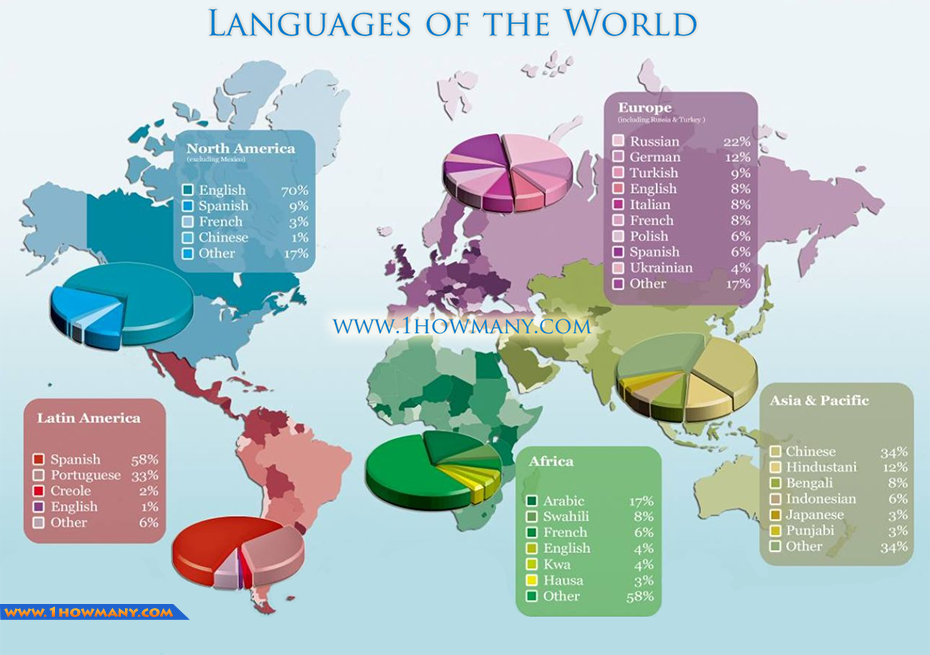
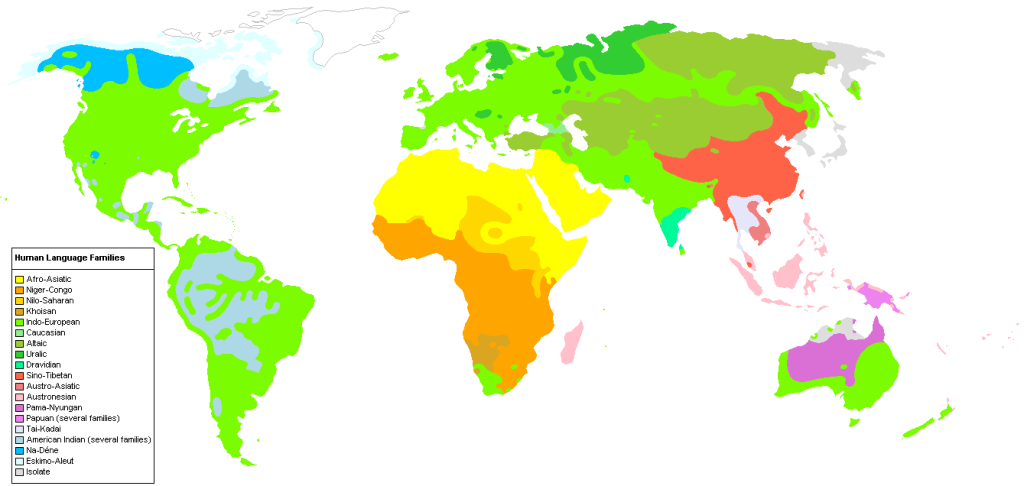
And now, we gotta dig a little deeper!
Caucasian (Caucasus)
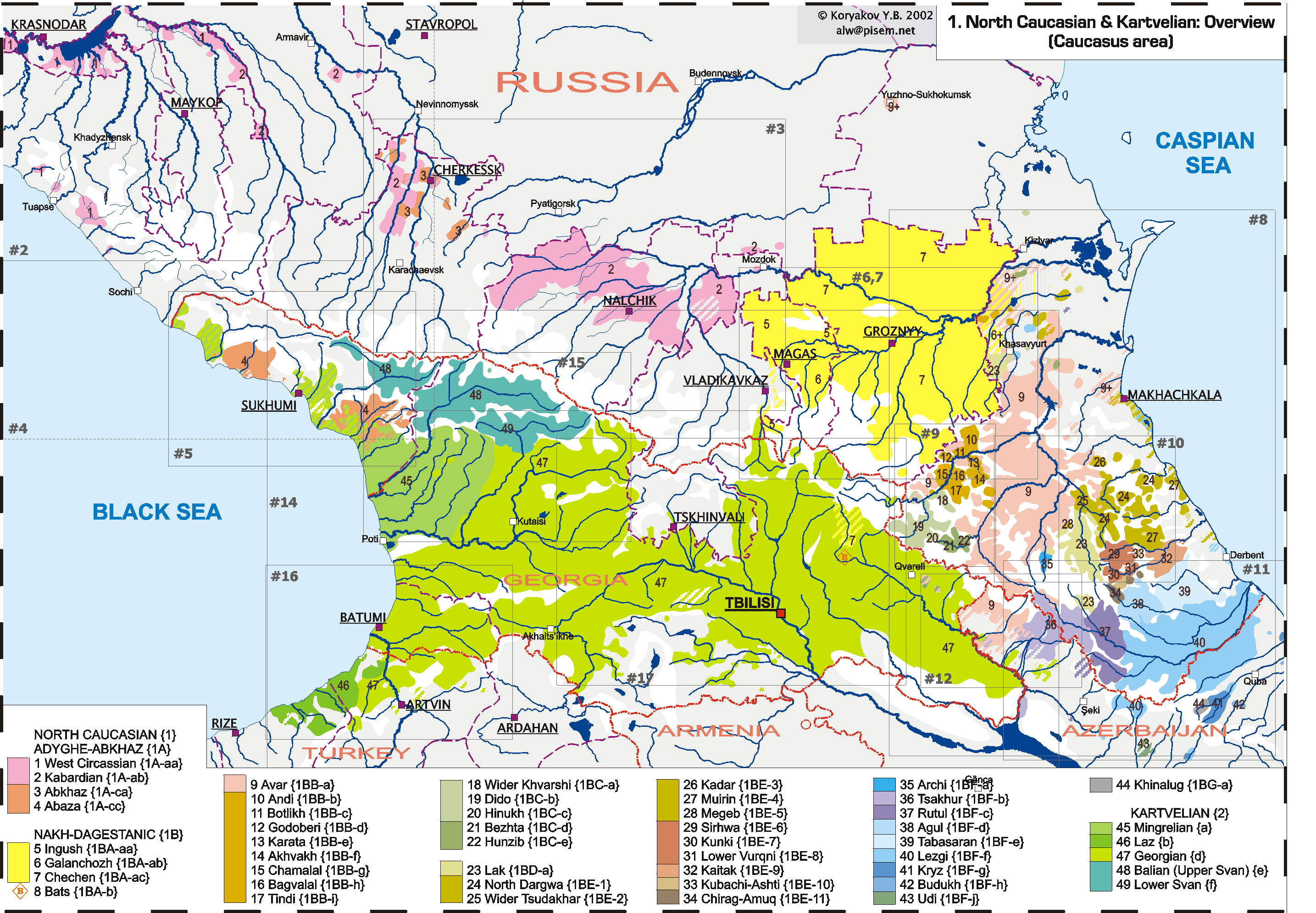
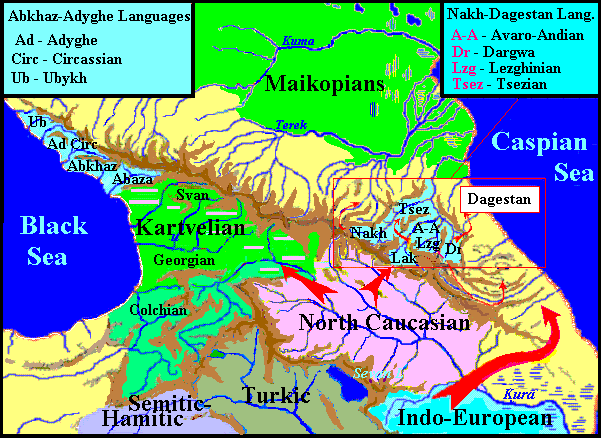
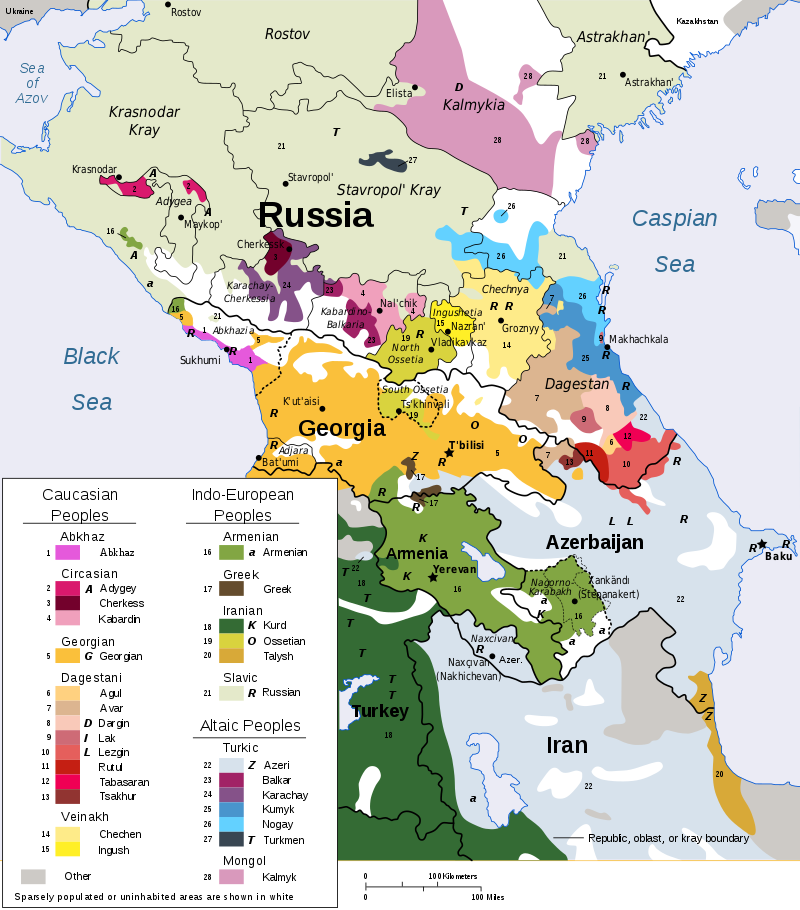
The Caucasian languages are a large and extremely varied array of languages spoken by more than ten million people in and around the Caucasus Mountains, which lie between the Black Sea and the Caspian Sea.
Linguistic comparison allows these languages to be classified into several language families, with little or no discernible affinity to each other. However, the languages of the Caucasus are sometimes mistakenly referred to as a family of languages.
(source : here)
The North Caucasian languages, sometimes called simply Caucasic, is a proposed language family consisting of a pair of well established language families spoken in the Caucasus, predominantly in the north, consisting of the Northwest Caucasian family (also called Pontic, Abkhaz–Adyghe, Circassian, or West Caucasian) and the Northeast Caucasian family (also called Nakh–Dagestanian or East Caucasian).
The Kartvelian languages including Georgian, Zan and Svan once known as South Caucasian, are no longer considered genetically related to the North Caucasian languages and are classed as an independent language family.
Many linguists join the Northwest and Northeast Caucasian languages into a North Caucasian family, sometimes simply called Kavkazian (in opposition to Kartvelian (South Caucasian), which is thought to be unrelated, albeit heavily influenced by their northern neighbours). This hypothesis has perhaps been best illustrated by Sergei A. Starostin and Sergei Nikolayev, who present a set of phonological correspondences and shared morphological structure.
Northwest Caucasian
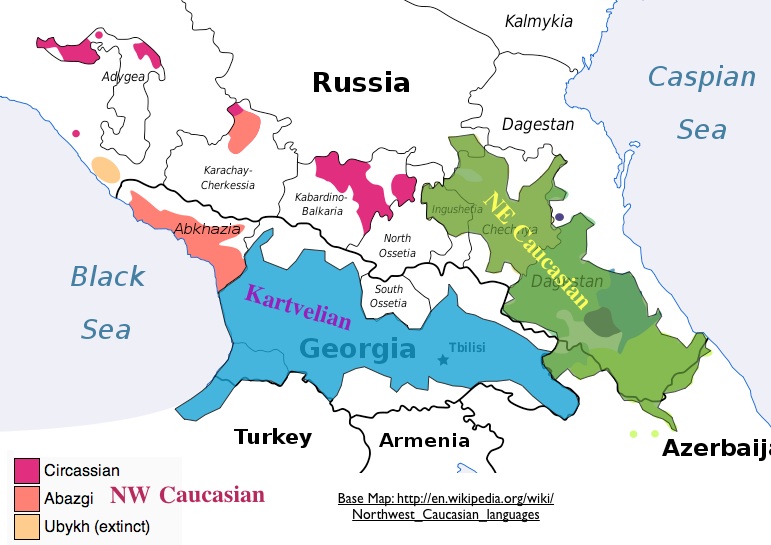
The Northwest Caucasian languages, also called West Caucasian, Abkhazo-Adyghean, Adyghe-Abaza, Circassic, or sometimes Pontic (as opposed to Caspian for the Northeast Caucasian languages), are a group of languages spoken in the northwestern Caucasus region, chiefly in three Russian republics (Adygea, Kabardino-Balkaria, Karachay–Cherkessia), the disputed territory of Abkhazia (whose sovereignty is claimed by Georgia), and Turkey, with smaller communities scattered throughout the Middle East. This language group’s relationship to other language families is uncertain. One language, Ubykh, became extinct in 1992, while all of the other languages are in some form of endangerment, with UNESCO classifying all as either “vulnerable,” “endangered,” or “severely endangered.
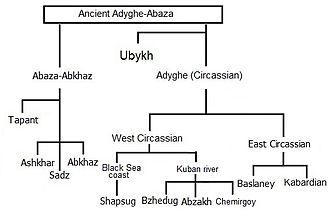
There are five recognized languages in the Northwest Caucasian family: Abkhaz, Abaza, Kabardian or East Circassian, Adyghe or West Circassian, and Ubykh. They are classified as follows:
- Abkhaz–Abaza (Abazgi)
- Abaza (49,800 speakers)
- Abkhaz (190,110 speakers)
- Circassian
- Adyghe (590,000)
- Kabardian (1,685,000)
- Ubykh †
Circassian (Cherkess) is a cover term for the series of dialects that include the literary languages of Adyghe and Kabardian.
- Adyghe is one of the more widely spoken Northwest Caucasian languages. It has 500,000 speakers spread throughout Russia and the Middle East: 280,000 in Turkey; 125,000 in Russia, where it is official in the Republic of Adygea; 45,000 in Jordan, 25,000 in Syria, 20,000 in Iraq, and 4,000 in Israel. There is even a small community in the United States. Four main dialects are recognised: Temirgoy, Abadzekh, Shapsugh and Bzhedugh, as well as many minor ones such as Hakuchi spoken by the last speakers of Ubykh in Turkey. Adyghe has a large number of consonants: between 50 and 60 consonants in the various Adyghe dialects but it has only three phonemic vowels. Its consonants and consonant clusters are less complex than the Abkhaz–Abaza dialects.
- Kabardian has just over one million speakers: 550,000 in Turkey and 450,000 in Russia, where it is an official language of the republics of Kabardino–Balkaria and Karachay–Cherkessia. Kabardian has the least number of consonants of any North-Western Caucasian language. Kabardian itself has several dialects, including Terek, the literary standard, and Besleney, which is intelligible with both Terek and Adyghe. Unlike the Adyghe, Kabardian lost many of the consonants that existed in the Proto-Circassian language, for example the consonants /ʃʷʼ/ /ʐʷ/ /ʂʷ/ /ʐ/ /ʂ/ /tsʷ/ /dzʷ/ became /fʼ/ /v/ /f/ /ʑ/ /ɕ/ /f/ /v/.
Abkhaz-Abaza (Abazgi). It is spoken mostly by the Abkhaz people. It is one of the official languages of Abkhazia . The literary dialects of Abkhaz and Abaza are two ends of a dialect continuum .
- Abkhaz has 100,000 speakers in Abkhazia (a de facto independent republic, but a de jure autonomous entity within Georgia), where it is the official language, and an unknown number of speakers in Turkey. It has been a literary language from the beginning of the 20th century. Abkhaz and Abaza may be said to be dialects of the same language, but each preserves phonemes which the other has lost. Abkhaz is characterised by unusual consonant clusters and one of the world’s smallest vowel inventories: It has only two distinctive vowels, an open vowel /a/ and a mid vowel /ə/. Next to palatalized or labialized consonants, /a/ is realized as [e] or [o], and /ə/ as [i] or [u]. There are three major dialects: Abzhuy and Bzyp in Abkhazia and Sadz in Turkey.
- Abaza has some 45,000 speakers, 35,000 in Russia and 10,000 in Turkey. It is a literary language, but nowhere official. It shares with Abkhaz the distinction of having just two phonemic vowels. Abaza is phonologically more complex than Abkhaz, and is characterised by large consonant clusters, similar to those that can be found in Georgian. There are two major dialects Tapant and Ashkhar. Some are partially intelligible with Abkhaz.
Ubykh forms a third branch, with parallels to both Adyghe and Abkhaz. The population switched to speaking Adyghe, and Ubykh became extinct on October 7, 1992, with the death of Tevfik Esenç. A dialectal division within Ubykh was suspected by Georges Dumézil, but the divergent form he described in 1965 was never investigated further. With eighty-one consonants, Ubykh had perhaps the largest inventory in the world aside from the Kx’a and Tuu families of southern Africa with their extensive system of clicks. There are pharyngealised consonants and a four-way place contrast among sibilants. It was the only Northwest Caucasian language never to have a literary form.
(source : here)
Northeast Caucasian
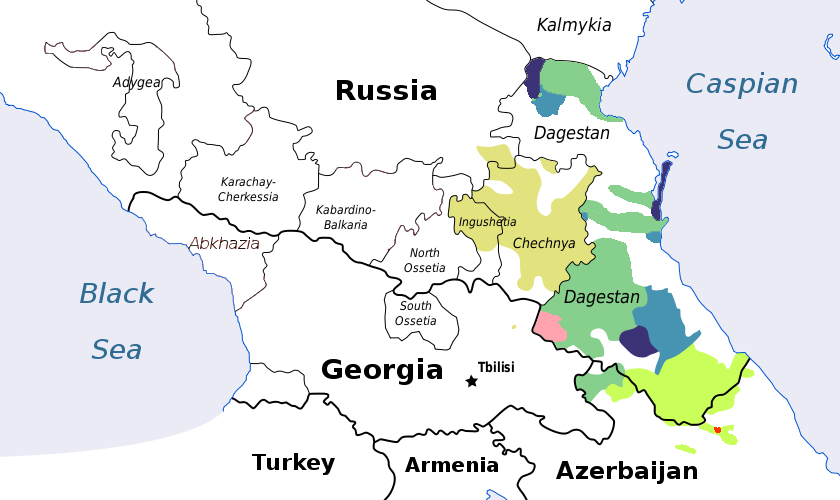
The Northeast Caucasian languages, or Nakh-Daghestanian languages, are a language family spoken in the Russian republics of Dagestan, Chechnya and Ingushetia and in northern Azerbaijan as well as in diaspora populations in Western Europe, Turkey and the Middle East. They are occasionally called North Caspian, as opposed to North Pontic for the Northwest Caucasian languages.
A long-time classification divided the family into Nakh and Dagestanian branches, whence the term Nakho-Dagestanian. However, attempts at reconstructing the protolanguage suggest that the Nakh languages are no more divergent from Dagestanian than the various branches of Dagestanian are from each other.

AVAR-ANDIC FAMILY
Spoken in the Northwest Dagestan highlands and western Dagestan. Avar is the lingua franca for these and the Tsezic languages and is the only literary language. Schulze (2009) gives the following family tree for the Avar–Andic languages:
- Avar (761,960)
- Andic languages
- Andi (Qwannab) (5,800)
- Akhvakh–Tindi
- Akhvakh (210 as of 2010)
- Karata–Tindi
- Karata (Kirdi) (260 as of 2010)
- Botlikh–Tindi
- Botlikh (210 as of 2010)
- Godoberi (130 as of 2010)
- Chamalal (500 as of 2010)
- Bagvalal–Tindi
- Bagvalal (1,450)
- Tindi (2,150)
Figures retrieved from Ethnologue. These languages are spoken in the following rayons of Dagestan: Axvax, Botlikh, Buynaksk (Shura), Čarodinsky (Tsurib), Gergebil, Gumbetovsky (Baklul), Gunib, Karabudaxkent, Kazbekovsky (Dylym), Lavaša, Tsumada (Agvali), Untsukul, Xebda, Xunzaq and Zaqatala rayon in Azerbaijan.
DARGIC (DARGIN) DIALECT CONTINUUM
Spoken by 492,490 in Dagestan, as well as Azerbaijan, Central Asia, and Ukraine. Dargwa proper is a literary language.
- Dargwa (Dargva)
- Kajtak
- Kubachi
- Itsari
- Chirag
Dargwa is spoken in the following rayons of Dagestan: Aquša, Kaitak, Kayakent, Kubači, Sergokala.
KHINALUG (XINALUG) isolate
Spoken in Quba rayon of Azerbaijan.
- Khinalug (Xinalug) (1,000 speakers)
LAK isolate
Spoken in the Central Dagestan highlands. Lak is a literary language.
- Lak (152,000 speakers)
Lak is spoken in two rayons of Dagestan: Kumux and Kuli (Vači).
LEZGIC FAMILY
Spoken in the Southeast Dagestan highlands and in Northern Azerbaijan. The Lezgian language or, as the Lezgian people themselves call it, Лезги чlал (lezgi ch’al), is the biggest in terms of the number of native speakers of all the languages of the Lezgic group (other languages from this group include Tabasaran, Udi, Tsakhur, and Rutul). They are spoken in the following rayons of Dagestan: Agul, Axty, Derbent (Kvevar), Kasumxur, Kurax, Magaramkent, Rutul, Tabasaran, Usuxčay, Xiv and Quba and Zaqatala in Azerbaijan. Tabasaran was once thought to be the language with the largest number of grammatical cases at 54, which could, depending on the analysis, instead be the Tsez language with 64.
Lezgian and Tabasaran are literary languages.
- Peripheral: Archi (970 speakers)
- Samur (or Nuclear Lezgian)
- Eastern Samur
- Tabasaran (128,900)
- Lezgian (655,000)
- Aghul (29,300)
- Udi (6,590)
- Southern Samur
- Kryts (5,000)
- Budukh (1,000)
- Western Samur
- Rutul (47,400)
- Tsakhur (23,673)
- Eastern Samur
NAKH FAMILY
Spoken in Chechnya, Ingushetia, and Georgia. Chechen and Ingush are official languages of their respective republics.
- Bats (3,420 speakers in Georgia in 2000)
- Vainakh languages
- Chechen (1,350,000)
- Ingush (322,900)
TSEZIC (Didoic) FAMILY
Spoken mostly in Southwest Dagestan. None are literary languages. Formerly classified geographically as East Tsezic (Hinukh, Bezta) and West Tsezic (Tsez, Khwarshi, Hunzib), these languages may actually form different subgroupings according to the latest research by Schulze (2009):
- Tsez–Hinukh
- Tsez (Dido) (12,500)
- Hinukh (Hinux, Ginukh) (5 as of 2010)
- Bezhta–Hunzib–Khwarshi
- Bezhta (Kapucha) (6,800)
- Hunzib (Gunzib) (1,420)
- Khwarshi (Khvarshi) (8,500)
These languages are spoken in Tsuntsin and Bežta areas of Dagestan.
(source : here)
Kartvelian / South Caucasian

Kartvelian (Iberian) are a language family indigenous to the South Caucasus and spoken primarily in Georgia, with large groups of native speakers in Russia, Iran, the United States, Europe, Israel, and northeastern parts of Turkey. There are approximately 5.2 million speakers of Kartvelian languages worldwide. The Kartvelian family is not known to be related to any other language family, making it one of the world’s primary language families. The first literary source in a Kartvelian language is the Old Georgian Bir el Qutt inscriptions, written in ancient Georgian Asomtavruli script at the once-existing Georgian monastery near Bethlehem, which dates back to c. 430 AD.
The Georgian script is the writing system used to write all Kartvelian languages, though the Laz language in Turkey is also written using a Latin script.
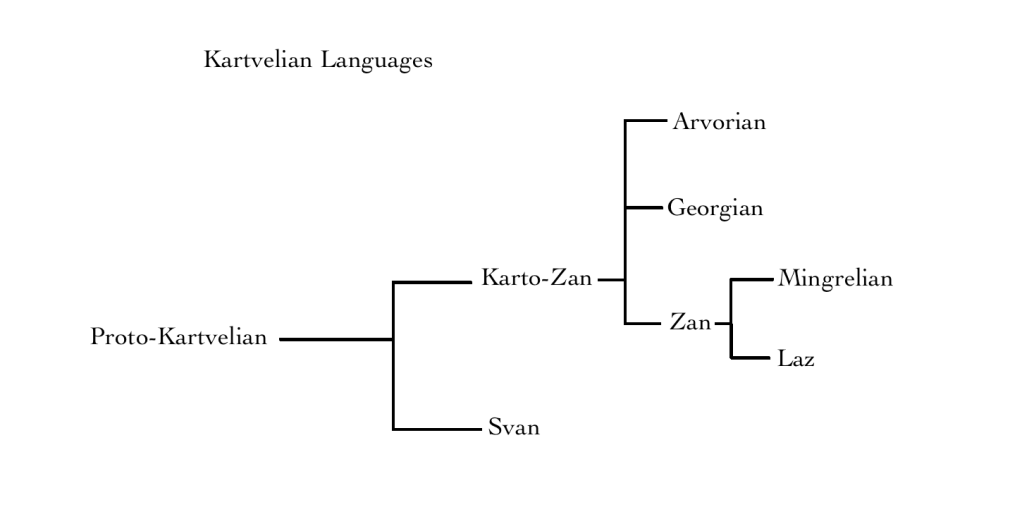
The Kartvelian language family consists of four closely related languages which form a dialect continuum:
- Svan (ლუშნუ ნინ, lušnu nin), with approximately 35,000–40,000 native speakers mainly in the northwestern mountainous region of Svaneti, Georgia, and in the Kodori Gorge of Abkhazia, Georgia.
- Georgian-Zan (also called Karto-Zan)
- Georgian (ქართული ენა, kartuli ena) with approximately 4 million native speakers, mainly in Georgia. There are Georgian-speaking communities in Russia, Turkey, Iran, Israel, and EU countries, but the current number and distribution of them are unknown.
- Zan (also called Colchian)
- Mingrelian (მარგალური ნინა, margaluri nina), with some 500,000 native speakers in 1989, mainly in the western regions of Georgia, namely Samegrelo and Abkhazia (at present in Gali district only). The number of Mingrelian speakers in Abkhazia underwent a dramatic decrease in the 1990s as a result of heavy ethnic cleansing of the Georgian population, the overwhelming majority of which were Mingrelians. The Mingrelians displaced from Abkhazia are scattered elsewhere in the Georgian government territory, with dense clusters in Tbilisi and Zugdidi.
- Laz (ლაზური ნენა, lazuri nena), with 22,000 native speakers in 1980, mostly in the Black Sea littoral area of northeast Turkey, and with some 2,000 in Adjara, Georgia.
(source : here)
(to be continued)

